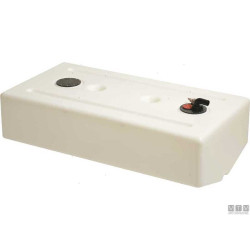
Water is one of the most vital resources on Earth, and managing its supply effectively is crucial for domestic, agricultural, and industrial use. One of the most efficient ways to store water is through water tanks. Whether it’s for drinking, irrigation, firefighting, or rainwater harvesting, water tanks provide a reliable and accessible means to store water for later use.
What Is a Water Tank?
A water tank is a container designed to hold water for various purposes. These tanks can vary in size from small, portable units to massive industrial reservoirs. They are used in homes, farms, factories, and commercial facilities to ensure that water is available when and where it is needed.
Water tanks are essential in areas where water supply is inconsistent or where conservation and storage are a priority. They are also critical in emergency situations, such as firefighting or drought response.
Types of Water Tanks
Water tanks come in different types based on their application, installation, and design. The most common types include:
1. Overhead Water Tanks
-
Installed on rooftops or elevated platforms.
-
Use gravity to supply water to plumbing systems.
-
Common in residential buildings and small businesses.
2. Underground Water Tanks
-
Installed below the ground level.
-
Ideal for areas with limited space or for aesthetic reasons.
-
Often used for rainwater harvesting or fire reserve water.
3. Ground-Level Storage Tanks
-
Placed directly on a flat surface.
-
Used in agriculture, industry, and rural homes for easy access.
-
Typically larger in size and used for bulk water storage.
4. Mobile Water Tanks
-
Installed on trailers or trucks.
-
Used for water transport, construction sites, and emergency services.
Materials Used in Water Tanks
The choice of material affects a tank’s durability, cost, and suitability for specific water types (e.g., drinking water, greywater, or chemical-laden water). Common materials include:
-
Plastic (Polyethylene): Lightweight, rust-free, affordable, and easy to install. UV-stabilized versions are used for outdoor use.
-
Steel (Galvanized or Stainless): Durable and ideal for large-scale or high-pressure systems. May require internal coatings to prevent rust.
-
Concrete: Extremely durable and suitable for underground use. Can be pre-cast or built on-site.
-
Fiberglass: Corrosion-resistant and lightweight. Used in marine or chemical industries.
-
Bladder Tanks: Flexible bags used for temporary water storage in remote or mobile applications.
Common Uses of Water Tanks
-
Domestic Use
-
Storing water for drinking, cooking, bathing, and flushing.
-
Rainwater harvesting systems.
-
-
Agricultural Use
-
Irrigation for crops and livestock watering.
-
Fertilizer mixing and spray tank storage.
-
-
Industrial Use
-
Process water storage.
-
Cooling systems and fire suppression.
-
-
Emergency Use
-
Firefighting reserves.
-
Disaster response and remote area water supply.
-
Benefits of Water Tanks
-
Water Security: Ensures water availability during supply interruptions or droughts.
-
Cost Savings: Reduces reliance on municipal water, especially when harvesting rainwater.
-
Environmental Sustainability: Helps conserve water and reduce runoff in urban areas.
-
Flexibility: Tanks can be installed in various locations and capacities to suit different needs.
Maintenance Tips
To ensure clean and safe water storage:
-
Clean the tank regularly (every 6–12 months) to remove sediment, algae, and debris.
-
Use filters or first-flush diverters in rainwater systems to prevent contamination.
-
Inspect for leaks, cracks, or rust and repair them promptly.
-
Cover the tank tightly to prevent insect and animal entry.
-
Test water quality periodically, especially if used for drinking.
Conclusion
Water tanks are a practical, cost-effective, and sustainable solution for water storage across a wide range of settings. With the growing need to manage water responsibly—especially in drought-prone or remote regions—water tanks offer a simple yet powerful way to improve water access, reduce costs, and support environmental stewardship. Whether in homes, farms, or industries, investing in a quality water tank is a smart move toward a more water-secure future.
